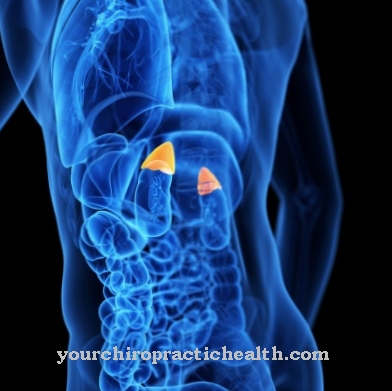The Cell communication is a process made up of intercellular and intracellular communication. Information is first exchanged between the cells via messenger substances. Within the cell, the signal is then passed on via receptors and secondary messenger substances and even amplified.
What is cell communication?

Cell communication is used to transmit external stimuli through signal transmission between the cells and within the cells. The external signal transmission takes place via special messenger substances such as hormones, neurotransmitter-mediated or ion-mediated electrical stimulus transmission, cell-bound surface molecules or high-molecular substances in the intercellular space.
The signals reach the inside of the cell via receptors or so-called gap junctions and trigger a cascade of reactions depending on the transmission path. Second messengers (secondary messenger substances) are formed in the cell, which transmit the signal to the target point and at the same time amplify it. A signal amplification takes place because an external signal results in the formation of a large number of second messengers.
In contrast to intercellular communication, in intracellular communication the signals are processed in the cell and converted into a reaction. Here the information is not transmitted from cell to cell, but forwarded by chemical messengers with amplification to the cellular destination. This entire process of intracellular communication is also known as signal transduction.
Function & task
Intracellular communication in multicellular organisms processes signals transmitted by extracellular messenger substances as well as by external stimuli (hearing, seeing, smelling). Signal transduction regulates important biological processes such as gene transcription, immune reaction, cell division, light perception, smell perception or muscle contraction.
The beginning of intracellular communication is triggered by extra- or intracellular stimuli. The extracellular triggers include hormones, growth factors, cytokines, neurotrophins and neurotransmitters. Furthermore, environmental influences such as light or sound waves are also extracellular stimuli.
Intracellularly, calcium ions often trigger the signal transduction cascades. The extracellular signals are initially picked up by receptors located in the cell or in the cell membrane. A distinction is made between cytosolic and membrane-based receptors.
Cytosolic receptors are located within the cell in the cytoplasm. They represent points of attack for small molecules that can easily pass through the cell membrane. These include steroids, retinoids, carbon monoxide and nitric oxide. After their activation, steroid receptors ensure the formation of second messengers, which are responsible for transcription processes.
The membrane-bound receptors are located in the cell membrane and have both extracellular and intracellular areas. During signal transmission, the signal molecules dock on the extracellular area of the receptor and, through its conformational change, ensure that the signal is passed on to the intracellular area. Biochemical processes then take place there, creating a cascade of second messengers.
The membrane-bound receptors are divided into three groups, the ion channels, the g-protein-coupled receptors and the enzyme-coupled receptors. In the case of the ion channels, there are again ligand-controlled and voltage-controlled ion channels. These are transmembrane proteins that are activated or deactivated depending on the signal and thereby change the permeability for certain ions.
When activated, a g-protein-coupled receptor causes the G-protein to break down into two components. These two components are active and ensure that the signal is passed on through the formation of certain second messengers.
Enzyme-coupled receptors are also membrane-based receptors that release the enzymes bound to them when signals are transmitted. There are six classes of enzyme-bound receptors. Depending on the activated receptor, the corresponding signals are implemented. For example, the receptor tyrosine kinase represents the receptor for the hormone insulin. The effect of insulin is thus mediated via this receptor.
Some cells are connected by so-called gap junctions. Gap junctions are channels between neighboring cells and represent a form of intracellular communication. When a signal reaches a certain cell, the gap junctions ensure its rapid propagation within the neighboring cells.
Illnesses & ailments
Disturbances in intracellular communication (signal transduction) are possible at many points in the signal transmission process and can have different health effects. Many diseases result from insufficient effectiveness of certain receptors.
If the immune cells are affected, immune defects occur as a result. Autoimmune diseases and allergies are caused by faulty processing of intracellular signal transmission processes. But diseases such as diabetes mellitus or arteriosclerosis are often the result of ineffective receptors. For example, there may be enough insulin in diabetes. Due to the lack of or ineffective insulin receptors, however, there is insulin resistance. As a result, even more insulin is produced. Eventually, the pancreas can become exhausted.
Many mental illnesses can also be traced back to disorders of intracellular cell communication, because in many cases signal transmission is not sufficiently guaranteed due to insufficiently effective receptors for neurotransmitters.
Neurotransmitters also play an important role in mental illness. For example, it is investigating which disorders in the complex processes of signal transmission can lead to diseases such as depression, mania, bipolar disorders or schizophrenia.
Genetic causes can also lead to a disruption of intracellular communication. A particular example of hereditary diseases relates to the gap junctions. As already mentioned, the gap junctions are channels between neighboring cells. They are formed by transmembrane proteins, the connexin complexes. Multiple mutations of these protein complexes can lead to profound hearing loss or even deafness. Their cause lies in the faulty function of the gap junctions and the resulting disruption in cell communication.












.jpg)



.jpg)










.jpg)
